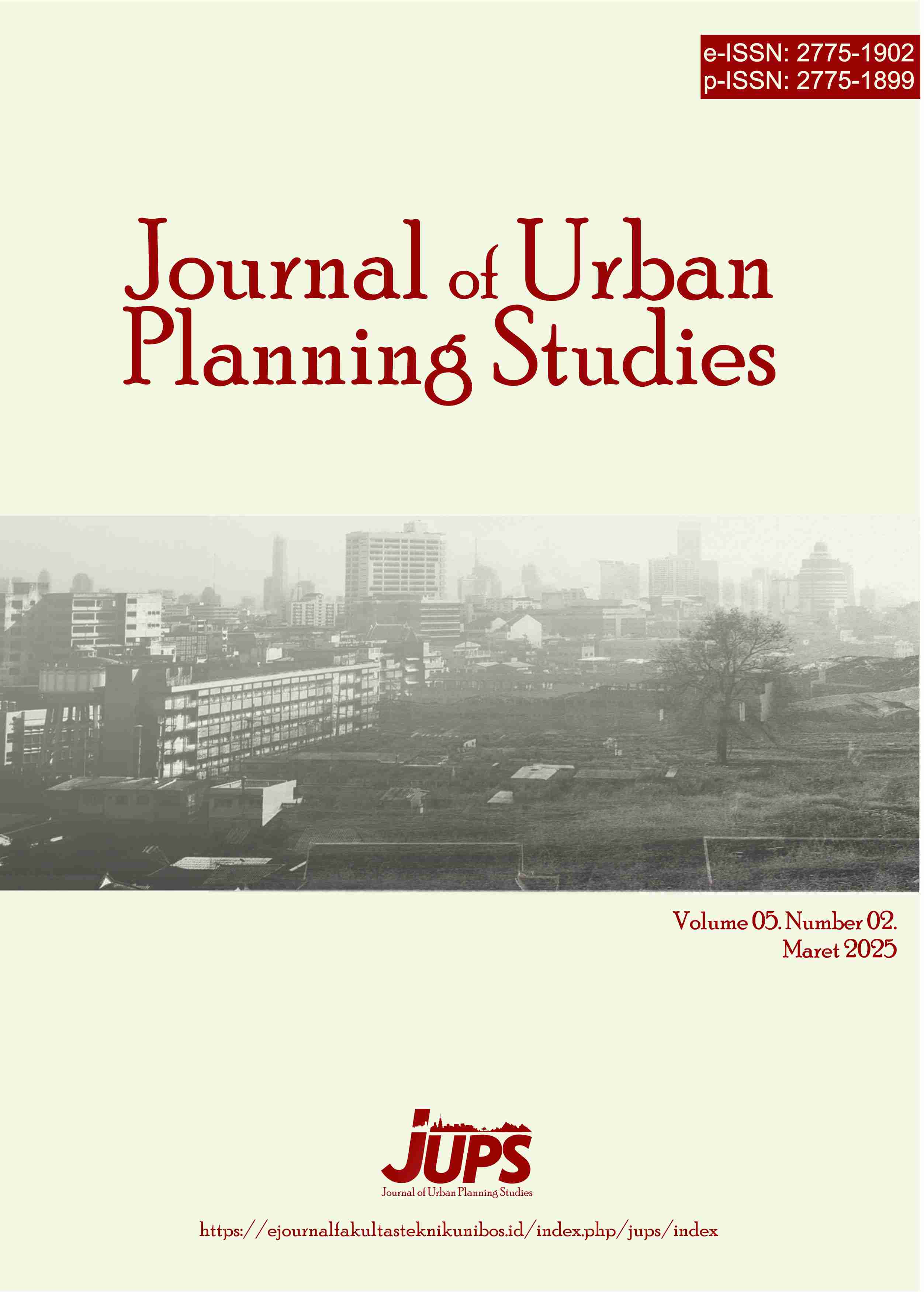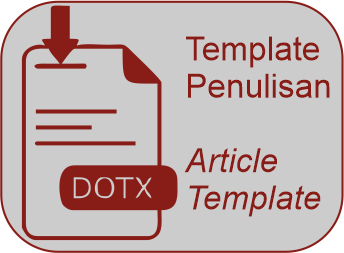Strategi Implementasi Smart Environment pada Permukiman Kumuh di Tengah Kota
Studi Kasus: Koridor Kanal Kelurahan Sinrijala, Kecamatan Panakukang, Kota Makassar
DOI:
https://doi.org/10.35965/jups.v5i2.658Keywords:
Smart City, Smart Environment, Permukiman, Permukiman KumuhAbstract
This research aims to analyze the factors that cause the development of slum settlements in the canal corridors of Sinrijala Village and formulate strategies for implementing smart environments in slum settlement areas in the canal corridors of Sinrijala Village. The research method used is Qualitative Descriptive Analysis carried out by interviews and field observations. Apart from that, in this research there are 4 (four) variables including land use, waste, water and sanitation.
References
Ahvenniemi, H., Huovila, A., Pinto-Seppä, I., & Airaksinen, M. (2022). What makes a sustainable smart city? Sustainable Cities and Society, 76, 103475.
Setyowati, E., Wahyudi, E., & Sudarsono, A. (2021). Urban slum and environmental degradation: The need for a community-based approach. IOP Conference Series: Earth and Environmental Science, 739(1), 012007.
Rahman, M., Alam, K., & Sohel, M. (2020). Environmental pollution and urban poverty in developing countries. Journal of Urban Management, 9(3), 275–287.
Albino, V., Berardi, U., & Dangelico, R. M. (2021). Smart cities: Definitions, dimensions, performance, and initiatives. Journal of Urban Technology, 28(1), 3–27.
Mora, L., Deakin, M., & Reid, A. (2022). Smart-city development paths: Insights from the literature and from international case studies. Cities, 123, 103557.
Li, Y., Yang, Y., Chen, Z., & Wang, Y. (2021). Integrating qualitative and quantitative methods to evaluate urban environmental governance. Sustainable Cities and Society, 64, 102528.
Karimi, M., & Hashemkhani Zolfani, S. (2021). Integrated urban planning using smart data-driven and participatory approaches for sustainable development. Sustainable Development, 29(3), 475–487.
Silva, T. R., & Serafim, M. P. (2022). Smart cities and environmental planning: A multidimensional approach. Journal of Cleaner Production, 332, 130026.
Bradshaw, C., Atkinson, S., & Doody, O. (2021). Employing a qualitative descriptive approach in health care research. Global Qualitative Nursing Research, 8, 1–9.
Satterthwaite, D., Archer, D., Colenbrander, S., Dodman, D., Hardoy, J., Mitlin, D., & Patel, S. (2020). Building resilience to climate change in informal settlements. One Earth, 2(2), 143–156.
Owusu-Ansah, J. K., & Braimah, I. (2022). Urbanisation and the dynamics of slums in Sub-Saharan Africa. Cities, 123, 103598.
Bibri, S. E., & Krogstie, J. (2021). Generating a vision for smart sustainable cities of the future: A scholarly backcasting approach. Sustainable Cities and Society, 61, 102295.
Ahvenniemi, H., Huovila, A., Pinto-Seppä, I., & Airaksinen, M. (2017). What are the differences between sustainable and smart cities? Cities, 60, 234–245.
Alizadeh, T., Sarkar, S., & Farrell, J. (2020). Smart city governance: The need for community-based approaches. Cities, 103, 102721.
López, R., González, A., & Martínez, J. (2021). Applications of drone-based remote sensing for land use and environmental monitoring. Environmental Monitoring and Assessment, 193(4), 1–15.
Smith, P., & Brown, R. (2022). The role of AIRMAP in urban drone operations and airspace safety. Journal of Urban Air Mobility, 6(1), 24–31.
Yang, Y., Wang, Y., & Li, D. (2023). Advancing urban planning through drone-based environmental monitoring and its impacts on sustainability. Journal of Environmental Management, 305, 113–124.
Zeng, W., Zhang, L., & Lu, X. (2023). The role of drones in monitoring urban land use changes and environmental impacts. Urban Studies, 60(7), 1419–1437.
Zhao, X., Yang, L., & Liu, B. (2021). Impact of real-time environmental monitoring systems on urban sustainability. Sustainability, 13(11), 6048.
Chen, L., Liu, Y., & Li, X. (2023). Smart waste management in informal settlements: A case-based approach. Sustainable Cities and Society, 95, 104671.
Kumar, R., & Joshi, Y. (2021). Decentralized wastewater management in low-income urban communities: A participatory framework. Environmental Science and Policy, 122, 34–45.
Li, S., & Wang, X. (2022). Spatial inequalities in access to clean water in urban slums. Cities, 122, 103572.
Lin, Y., Zhang, X., & Xu, H. (2021). Simplifying smart environment indicators for local governance. Urban Studies, 58(4), 723–740.
Rahman, M. M., Ahmad, S., & Hossain, M. (2022). Green space and mental wellbeing in urban slums: A multivariate analysis. Landscape and Urban Planning, 217, 104245.
Silva, C. M., Pereira, T. A., & Lima, R. A. (2023). Sanitation inequality and public health in urban peripheries: A comparative study. Habitat International, 135, 102712.
Tan, Y., & Goonetilleke, A. (2024). Context-sensitive indicators for smart city development in the Global South. Journal of Urban Management, 13(1), 89–103.
Zhang, J., Wu, C., & Hu, Y. (2023). Qualitative analytics for participatory smart environment planning. Sustainable Development, 31(2), 412–426.
García, J., Pérez, D., & López, F. (2023). Optimizing waste management through IoT and big data in urban environments. Environmental Monitoring and Assessment, 195(7), 421.
Rah, M. (2023). Impact of IoT and Big Data on sustainable waste management systems in urban areas. CNBC Indonesia. Retrieved from https://www.cnbcindonesia.com/tech
Santos, R., Oliveira, L., & Almeida, L. (2021). The role of IoT in waste management: Improving urban sustainability through smart waste systems. Journal of Environmental Engineering, 147(11), 04021072.
Zhang, T., Wang, X., & Yu, X. (2022). Smart waste management using IoT and big data for urban sustainability. Waste Management, 134, 12–22.
Chung, W., Kim, S., & Jang, H. (2021). Development of a real-time water quality monitoring system using IoT and sensors for environmental management. Environmental Monitoring and Assessment, 193(4), 215.
Zhang, Q., Xu, X., & Li, Y. (2022). Smart water quality monitoring system based on Arduino for environmental protection. Journal of Environmental Engineering, 148(11), 04022081.
Lee, H., Kim, H., & Park, J. (2021). Design and implementation of a real-time water quality monitoring system using wireless sensor networks and IoT technologies. Environmental Science and Technology, 55(6), 4215–4225.
Gondar, D., Silva, A., & Almeida, M. (2021). Anaerobic treatment of industrial wastewater in stabilization ponds: A review on performance and applications. Journal of Environmental Management, 284, 112005.
Kumar, M., Singh, S., & Gupta, A. (2021). Application of biofiltration in domestic wastewater treatment: Advances and challenges. Environmental Science and Pollution Research, 28(7), 8292–8308.
Said, A. S., Ariffin, M., & Ishak, M. (2022). Sustainable wastewater management in tropical climates: A case study on stabilization ponds for domestic wastewater treatment. Journal of Cleaner Production, 361, 132338.
Zhao, Y., Chen, M., & Zhang, H. (2023). Smart water management systems using IoT and sensors: Application in wastewater treatment. Journal of Environmental Engineering, 149(4), 04022041.
Downloads
Published
How to Cite
Issue
Section
License
Copyright (c) 2025 Wiyanda Dwi Rahayu, Syafri, Sudirman

This work is licensed under a Creative Commons Attribution 4.0 International License.













